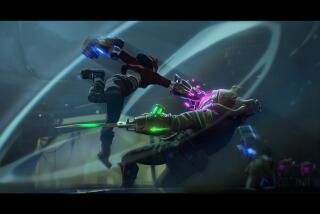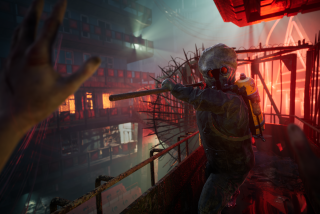With Innovative Pact, Video Game Makers Became Big Players
- Share via
A year ago, friends Josh Resnick and Andrew Goldman, veteran game developers at Santa Monica-based video game publisher Activision Inc. left to start their own firm, Pandemic Studios. Impatient with Activision’s stagnant stock price--and their own flagging stock options--they figured their best shot at a big payday lay in running their own outfit.
Activision could have shown the upstarts the back of its hand, but instead it has given them a big leg up, a sign that game developers--those keyboard-stroking techies who create mesmerizing video landscapes and stories--are starting to wield the same financial clout long enjoyed by their creative counterparts in film and TV.
Activision agreed to publish five titles from Pandemic, an unheard-of deal for a game start-up. It will also invest about $10 million as an advance against shared royalties in exchange for about a 5% stake in Pandemic.
What’s more, Activision handed Pandemic the rights to two of its successful war games. Pandemic’s first two games, due out this year, are sequels to the popular Activision titles “Dark Reign” and “Battlezone,” which sold a combined 700,000 copies worldwide.
“We created a structure that almost ensured their success,” said Robert Kotick, Activision’s chief executive.
Pandemic’s quick start puts it at the vanguard of the fast-changing video game industry. Publishers, battling in a competitive, $6.3-billion market, are now forced to secure the best talent by offering lucrative production deals, even to former employees.
“Activision has made an investment developing these people [at Pandemic]. Now Activision gets five titles from them and it has not lost them to the competition,” said Christian Svensson, editor in chief of MCV, a video game magazine.
Activision, with $437 million in annual sales, still has 350 in-house developers. But it and rival publishers, such as Redwood City, Calif.-based Electronic Arts, keep looking to buy games from outside developers.
Soaring production costs are fueling part of this outsourcing trend. The benchmark for an expensive video game used to be $1 million. Now $3 million is commonplace as players demand more sophisticated graphics and complicated action.
Former Activision executives figure the company would have spent $2.5 million using in-house talent to create a “Dark Reign” sequel.
But Resnick, Pandemic’s 32-year-old president, insists, “We can make a great game for under $2 million,” which is approximately what Activision will advance to the company for each of the five titles in the development deal.
And if Pandemic blows its numbers? “They have to eat the balance,” Activision’s Kotick said.
*
One look at Pandemic’s nondescript Santa Monica building, across from a liquor store and a shoe repair shop, and it’s clear that if the founders do go over budget, pricey digs won’t be the culprit. Pandemic’s entrance is a worn, red metal gate with an unmarked doorbell. There is no company sign. There is no receptionist. Resnick’s voice greets callers on the automated phone system.
Inside, Pandemic’s 26 employees--all young men in their early 20s to mid-30s--type away in three-walled rooms without doors. Video game posters are everywhere, and a Wurlitzer jukebox is ready to play.
Resnick hustled up office gear on the cheap: a used phone system for $850, desks for $5 and a “bachelor leather collection” of worn sofas. In the company’s fridge, sodas cost 25 cents, but beer is free on Friday nights.
Pandemic’s office might seem like a frat house to some, but the computer equipment is top-of-the-line. And Pandemic’s staff, mostly made up of Activision emigres, says it prefers this relaxed, creative environment to the low ceilings, standard cubicles and offices at Activision.
While the employees share childhood memories of playing video games and a love for creating new ones, they also are motivated by the chance to make a pile of money doing it.
Pandemic pays about the same salaries as Activision, but Resnick and Goldman will contribute half their royalties to a pool for their staff to share. In addition, about 50 cents of every dollar saved from the production budget goes into the royalty pool. Video game developer salaries typically run $25,000 for an entry-level post to $70,000 or more for a team leader, but Pandemic employees are betting they can pick up tens of thousands of extra dollars in bonuses.
To keep talent from leaving, Pandemic is offering another deal. “If you’re here the day we sell the company or go public, you get a percentage of the proceeds. If you’re not, you don’t,” Resnick said. “We tied incentives directly to the success of our products.”
That was enough to persuade former Activision employee Rick Glenn to become an art director at Pandemic. By joining, he gets a bonus package and later an equity stake. “It was a real no-brainer. I’m just playing the odds,” he said. “I have a better chance for the upside here.”
Like their staff, Resnick and Goldman are longtime video game hounds. Resnick’s fixation began when he was a teen, an interest he carried with him into his college years at Wharton, where he earned an MBA. He began his career in real estate but was still spending hundreds of dollars a year on games. So he applied at every video game company he could think of and got one job offer--from Activision, where he worked for four years, mostly as an associate producer.
Goldman, Pandemic’s chief executive, who is also 32, developed online video games at Prodigy before working five years as a game developer at Activision.
At Wharton, Resnick learned about problem-solving and negotiation, which came in handy when Activision assigned him to work out an exit deal with Goldman. When Goldman asked Resnick to join him, Activision was willing to structure a deal for both.
The partners’ goal is to create games that spread like an epidemic. Thus the firm’s sardonic name, and its logo: a head covered by a gas mask.
They figure they can make a tidy living from royalties, but their true ambition is to one day sell the company for $10 million to $50 million--not a wild idea considering Activision in the last year struck deals worth about $35 million to acquire two small gaming firms.
“Absolutely we want to make a huge killing, and I want all our guys to make a huge killing as well,” Resnick said.
First, of course, they have to sell some product.
There are 4,000 video games for sale in the U.S., with about 2,000 titles in the works. Only a fraction of those are destined to be profitable, but Pandemic has an advantage because it’s working on sequels for games with built-in audiences. “Dark Reign” sold about 500,000 copies worldwide and was a big hit in Germany and Australia, while “Battlezone” snagged critical awards and sold 200,000 units. Battlezone’s sequel is due in September, with “Dark Reign 2” set for Christmas.
*
Pandemic’s sequel to “Dark Reign” is a radical change. The new game boasts 3-D graphics, and the player can adjust how many hours or days the battlefield is covered by darkness or sunlight, which changes strategy. With a few mouse clicks, a player gets a 360-degree view of the battlefields, from above, behind or sideways.
The first “Battlezone” was also an action-strategy game, but it was packaged with sophisticated 3-D graphics and told the story of an intergalactic Cold War. The premise was that the U.S.-Soviet space race of the ‘60s was a cover story to grab critical alien technology, and the game featured tanks, infantry and assaults on Mars and Venus.
“ ‘Battlezone’ was one of the few games last year that blew me away,” said George Jones, editor in chief of Computer Gaming World.
In “Battlezone 2,” Pandemic included eight new worlds and added paratroopers with jet packs so gamers can play the role of both general and commando.
Pandemic’s first two games, which will retail for about $40, must sell about 125,000 units apiece to cover Activision’s advance of $2 million per game. A successful video game in this genre can generate $35 million in sales, with a developer’s royalty typically in the 10% to 25% range.
Both Pandemic games are designed for personal computers. Although popular titles designed for Sony or Nintendo consoles typically outsell PC games 3 to 1, profit margins can be bigger on PC games because there’s no royalty going to Sony or Nintendo. PC games also can be bundled into new PCs or included in software add-on packages, which can add $2 to $7 per unit to the publisher’s take. (“Battlezone,” for instance, ended up in an additional 1 million PC or software packages.) No matter which format, foreign sales are critical: 50% to 60% of game revenue comes from overseas.
To stoke fan interest, Pandemic is using grass-roots marketing, which means the Internet. The firm is promoting both new games on its Web site (https://www.pandemicstudios.com) with action shots, updates, e-mail chats with its designers and, later, game demos that can be downloaded. Pandemic’s “Battlezone” teaser has gotten up to 850,000 hits a day.
*
Computer Gaming World’s Jones has seen previews of both. “Pandemic could make a great name for themselves and a lot of cash,” he said.
While the early buzz is upbeat, Goldman knows about failure firsthand. He was on the 1988 U.S. Olympic team in Seoul, and his sailboat was in medal contention until it tipped over.
Still, he takes heart from hard-core fans of both games. One follower e-mailed wanting to know the exact release date for “Dark Reign 2” so he could schedule his vacation to play it right away. And at the Electronic Entertainment Expo in Los Angeles last month, Goldman was thrilled to spot a 6-year-old boy pounding away at “Battlezone 2.”
“If we do everything right,” Goldman said, “the money will follow.”







